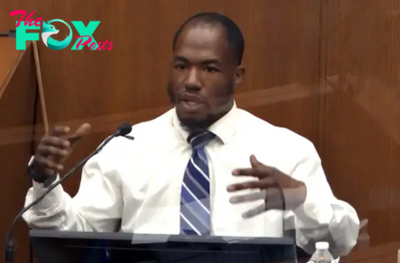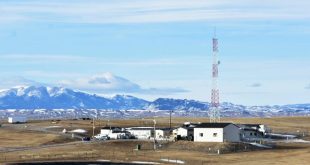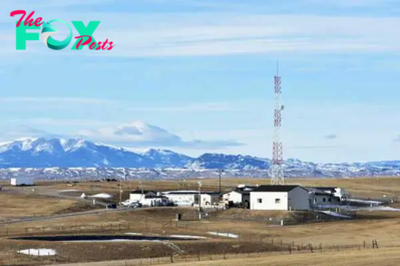US News
Evaporation takes center stage in Colorado River crisis
A lot of the Colorado River’s water is diverted from reservoirs and transported in canals to the farmlands and cities of the desert Southwest. However a few of the water additionally finally ends up going elsewhere — vanishing into skinny air.
Water misplaced to evaporation has turn out to be a central level of comPetition within the disagreement between California and 6 different states over the way to divide reductions in water use.
A proposal submitted by Arizona, Colorado, Nevada, New Mexico, Utah and Wyoming requires relying closely on counting evaporation and different water losses from reservoirs and alongside the river within the Decrease Basin — the portion of the watershed that begins close to the Grand Canyon and stretches to northern Mexico.
Counting these losses would imply fast reductions of greater than 1.5 million acre-feet throughout the area. It could additionally translate into particularly massive water cutbacks for California, which makes use of the only largest share of the river.
Beneath the proposal by the six states, Southern California water Businesses can be required to soak up the biggest share of the cuts, together with a possible discount of greater than 18% for the evaporation losses alone, which might rise to 32% if reservoirs hit critically low ranges.
The proposal additionally requires main reductions in Arizona and Nevada. However the parts of these cuts primarily based on accounting for evaporation can be smaller: about 13% for Arizona and 6% for southern Nevada.
California’s water managers argue that instantly together with evaporation within the math would quantity to a drastic rewriting of the foundations that might flout the water-rights system. They’ve proposed a different approach that requires extra gradual reductions and wouldn’t contain evaporation losses.
“California’s focus has been, what can we do in the interim that’s pragmatic, practical, doable, that’s not going to make big, lasting changes,” stated Wade Crowfoot, California’s pure assets secretary. He stated modifications that might compromise current water rights can be “a bridge too far in the near term.”
The Colorado River provides water to farming areas, cities and tribal nations from the Rocky Mountains to northern Mexico. Persistent overuse mixed with 23 years of severe drought and the consequences of local weather change have pushed the river’s two largest reservoirs, Lake Mead and Lake Powell, to their lowest ranges since they had been crammed.
The rising danger of a collapse within the water provide has prompted federal officers to demand that the states give you approaches for preventing reservoirs from bottoming out.
The states’ proposal calls evaporation and different water losses infrastructure safety volumes, or IPV, and says these quantities needs to be instantly utilized as reductions. Along with cuts in California, Arizona and Nevada, the proposal contains some potential reductions by Mexico, which might have to be negotiated.
Water managers in Arizona and Nevada say counting evaporation can be a good strategy to adapt and assist shut the gaping water deficit.
“It is the most equitable way to match the physical reality,” stated Tom Buschatzke, director of the Arizona Division of Water Assets. “It’s a simple thing to calculate and implement.”
The thought behind the proposal is that every water company can be assigned an quantity of estimated losses primarily based on the place the water is diverted and the way a lot evaporated, seeped out or was taken up by vegetation alongside the way in which.
“Everyone is used to historically getting their full entitlement and the losses being assessed against the system, not against their entitlement,” Buschatzke stated. “So every single water user is going to have less water to use than they have had historically.”
The federal Bureau of Reclamation is contemplating the proposals as a part of a overview and taking a look at choices for making cuts as they determine the way to revise the foundations for coping with shortages. They plan to finalize a call this summer season.
The proposal from the six states attracts on solutions by Las Vegas’ water managers on the Southern Nevada Water Authority, who known as for “equitable sharing of evaporation and system losses” in a December proposal to the federal authorities.
The Nevada water company presented an analysis final yr estimating the water losses between Lees Ferry, positioned simply downstream from Glen Canyon Dam, and the U.S.-Mexico border, together with losses from the reservoirs Lake Mead, Lake Mohave and Lake Havasu, in addition to alongside the river.
The evaluation divided the losses among the many three states and Mexico, and in addition calculated particular person “assessments” for Businesses that provide farms and cities, in addition to for different entities, such because the Colorado River Indian Tribes, whose water flows to farmland beside the river.
Utilizing this method, the most important reductions would fall to California’s Imperial Irrigation District, which makes use of the only largest share of the river to provide farms within the Imperial Valley that produce crops together with hay for cattle, wheat and greens comparable to lettuce and onions.
The proposal has farmers involved.
“Evaporation has never been part of the equation,” stated John Hawk, a farmer and Imperial County supervisor. “That’s rewriting the rules. That’s what they want to do. They want to hammer away at priority users.”
Nevada’s evaluation final yr listed a possible discount of greater than 500,000 acre-feet for the Imperial Irrigation District, which is about 20% of its annual water use.
The Imperial Irrigation District holds a few of the most senior water rights on the river, relationship to 1901. Beneath the prevailing water-rights system, that makes the district among the many final in line to be required to take cuts in a scarcity.
Farmers and landowners, in addition to Southern California water officers, say they’re involved about makes an attempt to undermine the authorized system governing water use that has developed during the last century, known as the Law of the River.
“We all live by rules and agreements. This new idea, evaporation on the river, would negatively impact Imperial,” Hawk stated, including that such massive reductions would deliver an financial blow on either side of the California-Mexico border, affecting communities that depend upon agriculture.
Factoring within the water misplaced to evaporation would additionally have an effect on the Metropolitan Water District of Southern California, which provides 26 member Businesses that serve 19 million folks. MWD officers say preliminary estimates primarily based on the six-state proposal level to a possible discount of at the very least 15% to twenty% for evaporation losses, plus further important cuts.
“It would affect us disproportionately,” stated Invoice Hasencamp, MWD’s supervisor of Colorado River assets. “This isn’t a be-all, end-all proposal. And frankly, Reclamation is going to have a hard time modeling this proposal.”
Representatives of the seven states plan to carry extra negotiations in non-public, and lots of have stated that regardless of the disagreements, they may proceed making an attempt to succeed in a consensus.
J.B. Hamby, the chair of California’s Colorado River Board, known as the thought of factoring in evaporation losses “troubling and problematic,” and stated it “does not harmonize with the Law of the River as we all know it.”
The dispute has roots within the agreements, court docket choices and guidelines that govern how the river is managed.
The 1922 Colorado River Compact divided water among the many seven states. However the concern of evaporation has lengthy been handled otherwise within the river’s Higher Basin states — Colorado, Wyoming, Utah and New Mexico.
Beneath a 1948 compact, the Higher Basin states outlined “consumptive use” of water primarily based on the “man-made depletions of the virgin flow” of the river at Lees Ferry, the dividing line between the higher and decrease components of the basin.
For these states, water losses to evaporation have lengthy been counted in opposition to their apportionments, stated Eric Kuhn, an writer and former Colorado water supervisor.
However within the three Decrease Basin states, Kuhn stated, these losses had been by no means thought-about as a part of the water supply contracts. The quantity of water used has been calculated as the quantity diverted minus return flows to the river — which occurs in farming areas comparable to Blythe, had been water flows off farmlands and runs again into the Colorado.
That method was supported by the U.S. Supreme Courtroom in its landmark 1963 resolution within the case Arizona vs. California and its subsequent 1964 decree, which settled a longstanding dispute between the states over Colorado River water.
Kuhn stated the battle “all goes back to the definition of consumptive use,” and he hopes the 2 sides can attain a compromise on the difficulty.
Different consultants have supported the thought of taking evaporation losses under consideration.
“The pain has to be shared broadly,” stated John Fleck, a water researcher and author in residence on the Utton Heart on the College of New Mexico’s College of Legislation. “This is a method for responding to the reality that climate change has fundamentally changed the nature of the river from the one we made all these deals about over the last century.”
In his proposal to the federal authorities, Fleck wrote that by ignoring these losses, the Supreme Courtroom “pointed the river’s management bus toward a ditch.”
“In the years since, we were unable to grab the wheel and turn it,” Fleck wrote. “We are now in that ditch.”
Evaporation ought to have been included into the allocations from the start, stated Kathy Jacobs, director of the College of Arizona’s Heart for Local weather Adaptation Science and Options.
“It is clearly fair to count losses to evaporation in proportion to the size of the allocations as a way to achieve cuts,” Jacobs stated, “but it is unfortunately not enough.”
Local weather change has dramatically altered the river. Within the final 23 years, as rising temperatures have intensified the drought, the river’s stream has declined about 20%.
Scientists have discovered that roughly half the decline within the river’s stream has been caused by higher temperatures, and that for every further 1 diploma Celsius (1.8 levels Fahrenheit) of warming, the river’s common stream in all probability will decrease about 9%.
“Fundamentally, the seeds of this current situation were planted decades ago when the U.S. decided to irrigate a desert with Colorado River water,” stated David Pierce, a local weather scientist at Scripps Establishment of Oceanography. He identified that about 80% of the river’s water continues going to farming.
“The system was carefully calibrated to just break even in the absence of climate change. Climate change is that last push on water availability that throws the whole system off,” he stated.
Pierce stated he thinks it might make sense to account for evaporation losses. He identified that Lake Mead has been dropping about 6 feet of water per year to evaporation, though the losses lower because the reservoir shrinks.
“The issue, of course, is whose allocation the evaporation is taken out of,” Pierce stated. “I’m sure there will be many arguments about that.”
#usanews #usa_news
-

 US News11h ago
US News11h agoParamedic Who Injected Elijah McClain With Ketamine Before His Death Avoids Prison
-

 US News18h ago
US News18h agoAmateur Wall Street Investors are Making Millions Rooting for Trump’s Truth Social to Fail
-

 US News1d ago
US News1d agoU.S. Announces New Patriot Missiles for Ukraine as Part of $6B Aid Package
-

 US News1d ago
US News1d agoMinneapolis Approves $150K Settlement for Witness to George Floyd’s Murder
-

 US News1d ago
US News1d agoBiden Administration to Implement Most Sweeping Gun Export Regulations in Decades
-

 US News1d ago
US News1d agoHow TIME100 Gala Attendees Reacted to Harvey Weinstein’s Overturned Rape Conviction
-

 US News1d ago
US News1d agoUSC Cancels Main Commencement Ceremony Amid Israel-Hamas War Protests
-

 US News1d ago
US News1d agoDo Americans Have a Constitutional Right to Use Drugs?































